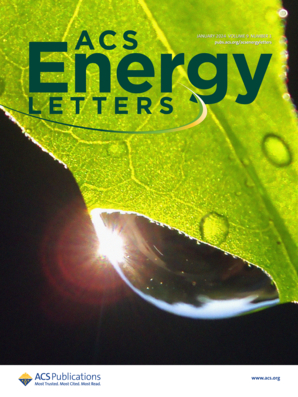Interface Engineering with Multiple Functional Groups Coupling for High-Voltage and Wide-Temperature Sodium Metal Batteries
IF 19.3
1区 材料科学
Q1 CHEMISTRY, PHYSICAL
引用次数: 0
Abstract
High-voltage sodium metal batteries (SMBs) with layered oxide cathodes face safety and stability challenges due to electrolyte decomposition and unstable electrode/electrolyte interphases. This study proposes a multifunctional electrolyte design strategy coupling nitrile, fluorine, and ether groups to enhance the high-voltage stability. The optimized electrolyte promotes formation of a thin, uniform cathode electrolyte interphase containing N/F-rich components (CN-, CNO-, NaNxOy, NaF) and a NaF-rich solid electrolyte interphase, effectively inhibiting electrolyte degradation and transition-metal dissolution. The modified electrolyte enables SMBs to deliver a 103.4 mAh g–1 initial capacity at 10 C (2.0–4.5 V) with 99.63% average Coulombic efficiency over 200 cycles. Moreover, it supports stable operation across −20 to 60 °C, providing design insights for high-voltage wide-temperature SMBs.

高压宽温钠金属电池多官能团耦合界面工程
由于电解质分解和电极/电解质界面不稳定,具有层状氧化物阴极的高压钠金属电池(smb)面临安全性和稳定性方面的挑战。本研究提出了一种结合丁腈、氟和醚基团的多功能电解质设计策略,以提高高压稳定性。优化后的电解质促进了含有富N/ f组分(CN-, CNO-, NaNxOy, NaF)的薄而均匀的阴极电解质界面和富N/ f的固体电解质界面的形成,有效抑制了电解质的降解和过渡金属的溶解。经过修饰的电解质使smb在10℃(2.0-4.5 V)下提供103.4 mAh g-1的初始容量,200次循环的平均库仑效率为99.63%。此外,它支持−20至60°C的稳定运行,为高压宽温smb提供了设计见解。
本文章由计算机程序翻译,如有差异,请以英文原文为准。
求助全文
约1分钟内获得全文
求助全文
来源期刊

ACS Energy Letters
Energy-Renewable Energy, Sustainability and the Environment
CiteScore
31.20
自引率
5.00%
发文量
469
审稿时长
1 months
期刊介绍:
ACS Energy Letters is a monthly journal that publishes papers reporting new scientific advances in energy research. The journal focuses on topics that are of interest to scientists working in the fundamental and applied sciences. Rapid publication is a central criterion for acceptance, and the journal is known for its quick publication times, with an average of 4-6 weeks from submission to web publication in As Soon As Publishable format.
ACS Energy Letters is ranked as the number one journal in the Web of Science Electrochemistry category. It also ranks within the top 10 journals for Physical Chemistry, Energy & Fuels, and Nanoscience & Nanotechnology.
The journal offers several types of articles, including Letters, Energy Express, Perspectives, Reviews, Editorials, Viewpoints and Energy Focus. Additionally, authors have the option to submit videos that summarize or support the information presented in a Perspective or Review article, which can be highlighted on the journal's website. ACS Energy Letters is abstracted and indexed in Chemical Abstracts Service/SciFinder, EBSCO-summon, PubMed, Web of Science, Scopus and Portico.
 求助内容:
求助内容: 应助结果提醒方式:
应助结果提醒方式:


